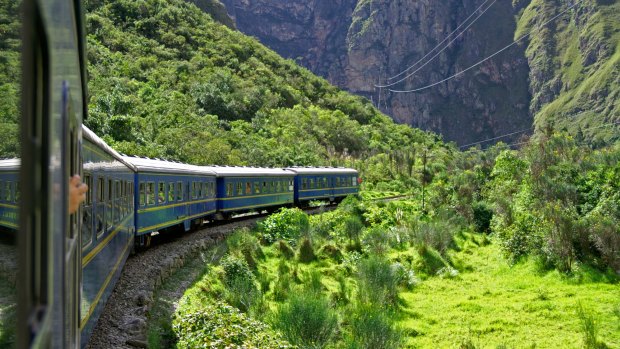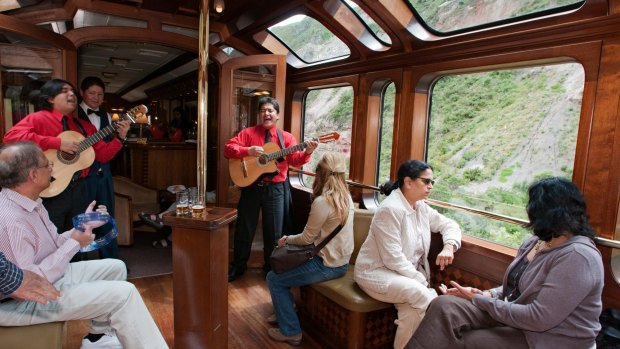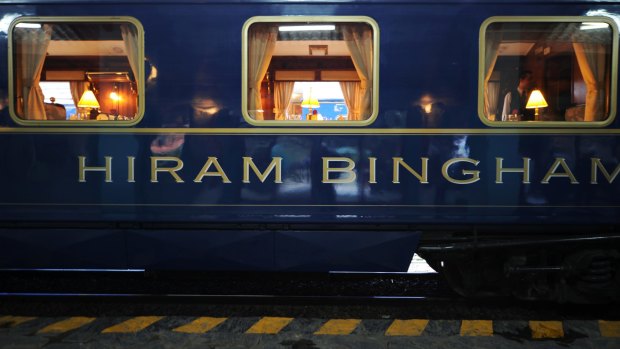This was published 7 years ago
Luxury train to Machu Picchu: On board the Belmond Hiram Bingham

The ruins of Machu Picchu.Credit: Adobe Stock
Compared to the historic core of Cusco – all sloping cobbled streets, arcade-fringed plazas and baroque churches – the nearby town of Poroy, with its humble, lowrise adobe houses, isn't much to write home about. At first glance, anyway. But entering its little railway station, I find a scene to rouse the senses. To a soundtrack of soothing Andean pipe and drum music, a trio of young Peruvian women cloaked in brightly-coloured woven attire are dancing on the platforms, their skirts fluttering through the crisp early-morning mountain air.
Behind them is a train that looks like a life-sized version of something from the old model railway set of my childhood. With shiny carriages in navy blue and gold livery, Belmond Hiram Bingham is one of the world's most luxurious trains. Renowned for its fine dining, ambient live entertainment and jaw-dropping window views, it goes to Machu Picchu and is named after the Indiana Jones-like explorer who "rediscovered" this legendary "Lost City of the Incas" in 1911.
The citadel was probably built in the mid-1400s, at the height of the Incas' powers, but as their empire crumbled following the early 16th-century invasion of Peru by the Spanish conquistadors, Machu Picchu was abandoned and gradually reclaimed by the luxuriant Andean jungle.

Why trek when you can take the train?Credit: Adobe Stock
Bingham, a Yale University lecturer, located the site with the assistance of indigenous farmers and travelled there by mule.
Many tourists take similarly arduous routes from Cusco today, lugging their backpacks for days along well-trodden paths such as the Inca Trail. There are also "regular" trains that make the journey. But nothing can match the opulence and bygone charm of the Belmond Hiram Bingham (which is perhaps not surprising considering a round-trip fare is about $1170).
Sipping a "welcome" flute of bubbly proffered by one of the waist-coated guards, I hop on board and immediately feel as if I've walked into an Agatha Christie story. All polished wood panels, brass fittings and fine fabrics, the carriages are designed like the elegant Pullman trains of the 1920s created by American engineer George Mortimer Pullman.

Music and views aboard the Hiram Bingham.Credit: Sergi Reboredo / Alamy Stock Photo
For most of the almost four-hour journey, which sees us travel 93 kilometres via the Sacred Valley of the Incas, descending more than 1400 metres in altitude, I'm happy to lounge in my comfy upholstered seat, admiring the Andean scenery. There's also a rather delicious brunch to savour, packed with seasonal ingredients, largely sourced from the Sacred Valley. You can expect the likes of roast alpaca loin and corn, paired with South American wine (Argentine reds, Chilean whites or Peruvian sparkling), followed by a dessert such as baby papaya, passion fruit and chocolate chip cheesecake drizzled with strawberry sauce.
After an organic caffeine pick-meup, I take a stroll to the observation coach. Here I find a convivial bar with musicians playing upbeat Latin guitar and maraca tunes, and floor-to-ceiling windows that reveal the beautiful scenery. We pass gushing rivers and jungly peaks, trekkers and roaming llamas, and Quechua farmers and their oxen ploughing patchwork fields of corn, quinoa, potatoes and beans. Direct descendants of the Incas, the Quechua have had roots in the Andes for several millennia.
We also whoosh past an old battleground where, in 1438 under their leader Pachacutec, the Incas quashed the rival Chanca tribe, sparking an expansionist drive across the Andes and paving the way for new settlements such as Machu Picchu.

The elegant carriages hark back to another era. Credit: Alamy
When Bingham located the citadel, perched 2430 metres above sea level, it was shrouded in dense overgrowth. Arriving today, following a short bus transfer from nearby Aguas Calientes train station, we find this UNESCO World Heritage site looking neat and tidy, with a network of marked footpaths and signs.
There is a timeless quality to Machu Picchu, however, and surveying it from a panoramic viewpoint, I recall an excerpt I'd read in the train's keepsake brochure quoting Bingham writing in his 1948 book, Lost City of the Incas.
"In the variety of its charms and the power of its spell, I know of no place in the world which can compare with it. Not only has it great snow peaks looming above the clouds more than two miles overhead, gigantic precipices of many-coloured granite rising sheer for thousands of feet above the foaming, glistening, roaring rapids, it also has, in striking contrast, orchids and tree ferns, the delectable beauty of luxurious vegetation and the mysterious witchery of the jungle."
Considering its popularity – almost every South American-bound traveller wants to "tick" Machu Picchu off their bucket list – the atmosphere amid the ruins is surprisingly serene (it helps if you come outside the July-August peak). Indeed, the tranquillity is only really broken by our tour guides waxing lyrical and security guards occasionally whistling to stop visitors tramping where they shouldn't.
As we explore, climbing steps and terraces, our guide points out the intricacies of the Inca stonework and relates myriad facts, myths and legends. But he can't tell us exactly why this place was built. No one really can. Theories abound – it may have been a ceremonial base, a centre of astronomy or a holiday pad for the Inca king – but the mystery endures.
Adventurous types love scaling Huayna Picchu, the steep mountain that sits directly behind Machu Picchu. We don't have time for that, but we do take afternoon tea at the adjacent Belmond Sanctuary Lodge, a five-star retreat in which you can overnight then return to Cusco – or your next destination – another day.
After one last glance at the misttickled ruins, I bus it back to Aguas Calientes and reboard the Hiram Bingham, where staff ply me with a pisco sour, a zesty Peruvian staple of brandy, lemon juice, egg white and sugar syrup. Later, we're served a four-course dinner of king crab galette, cream of pumpkin soup, beef tenderloin medallion with oyster mushrooms and peanut brownies in butterscotch sauce (alternatively, you may have something like kiwicha caviar and Pumahuanca salt-crusted trout).
As my china plates are taken away, I hear music floating gently through the carriage: guitars, tambourines and the cajón (a box-shaped percussion instrument). With Cusco still a few hours away, I close my eyes, reflect on today's once-in-a-lifetime jaunt and drift off into a hard-earned nap.
The Belmond Hiram Bingham operates daily between May and December, except for the last Sunday of each month. The service is only partially available during the rainy season, which runs from January to April. See belmond.com for more information.
The writer travelled as a guest of the Belmond Hiram Bingham.
Sign up for the Traveller Deals newsletter
Get exclusive travel deals delivered straight to your inbox. Sign up now.